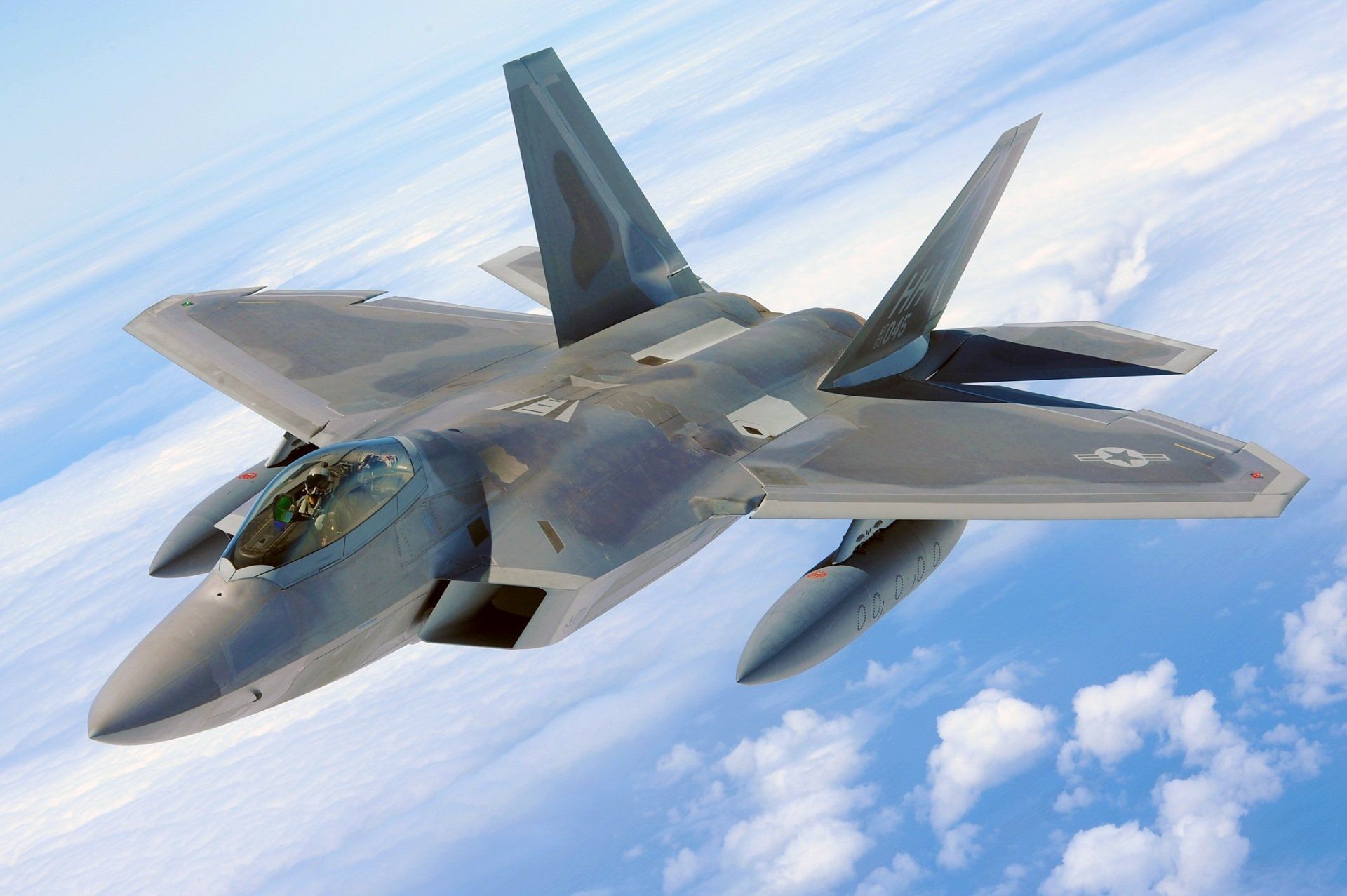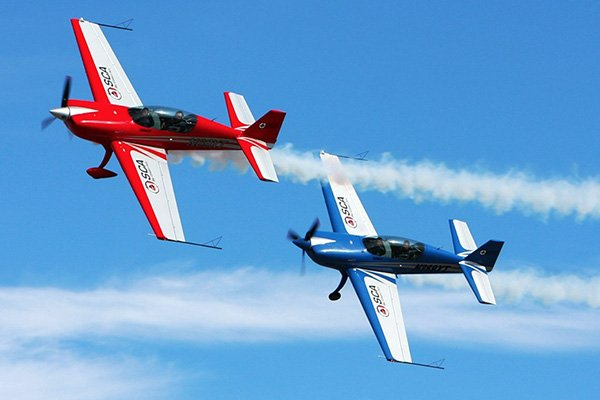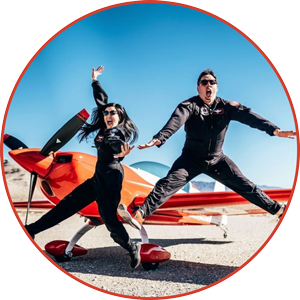How to Train Like a Fighter Jet Pilot

There are few things more thrilling than flying a fighter jet! These precision aircraft can soar through the sky at top speeds with the ability to perform spins, rolls, tailslides, and tumbles under the expert control of the best pilots in the world. The rigorous training to become a fighter jet pilot encompasses everything from technical aviation skills to physicality and flight discipline to mental aptitude.
If you want to learn more about what it’s like to fly in a fighter jet, our skilled aerobatic pilots at Sky Combat Ace answer frequently asked questions about fighter jet flight training.
Now It’s Your Turn to Take the Controls:
How Can I Become a Fighter Jet Pilot in the USA?
Before you can even qualify to become a fighter jet pilot in the United States, there are several things to consider. Indeed¹ lists the steps to become a U.S. Air Force pilot as:
- Join the Air Force
- Earn a bachelor's degree
- Meet officer qualifications
- Attend officer training school
- Pass initial flight training
- Pass undergraduate pilot training
As you can see, it’s much more than just showing up at an Air Force base to learn how to fly! Successfully operating a
fighter jet involves academic, physical, and mental training. You must also achieve the rank of an officer, take specialized pilot training classes, and pass comprehension and mathematical tests as part of the application process.

How Hard Is It to Become an Air Force Pilot?
The United States Air Force (USAF) has strict qualifications² to become a pilot, including:
- Understand flight theory, air navigation, meteorology, flying directives, aircraft operating procedures, and mission tactics
- Complete USAF specialized undergraduate pilot training
- Pass single scope background investigation (SSBI)
- Complete Officer Training School (OTS), Air Force Academy (AFA), or Air Force Reserve Officer Training Corps (AFROTC)
- Was between the ages of 18 and 33 when pilot training started
- Height specifications (vary by aircraft) to ensure safe performance of operational duties
Very few pilots achieve the level of training and skills to get behind the stick of a real fighter jet in the U.S. Air Force. It takes hard work, dedication, and passion to become an Air Force pilot.
Where Can a Civilian Learn to Fly a Fighter Jet?
If you want to learn to fly a fighter jet as a civilian, there are private programs for certified pilots to become trained and rated to fly these types of aircraft. Remember, it’s crucial to find pilot training courses and certified instructors that follow all FAA guidelines to ensure your safety while learning to fly a jet fighter!
You can also book an adrenaline-pumping fighter jet experience and take to the skies with a trained fighter pilot at Sky Combat Ace.
Contact our team to learn more.
The whole experience was awesome!!! This was a bucket list dream come true. Everyone was great to work with and my pilot was the greatest. The airplane is like nothing you have experienced before. I highly recommend this to anyone who has ever wanted to experience stunt flying, not only as a passenger but as the pilot.
Patrick B five star review on TripAdvisor,
How Long Does It Take to Learn to Fly a Fighter Jet?
Training to become a fighter jet pilot can take roughly about 2 years in the Air Force. You must earn your wings, pass all Air Force requirements, then go through months of training in the fighter jet before you can successfully complete air combat missions. Years of practice flying the aircraft is the only way to become proficient.
What Plane Is Used to Train Cadet Fighter Pilots?
USAFA cadets complete initial pilot training courses in a virtual T-6 Texan II³, which is a high fidelity virtual reality fighter jet simulator, before live flights. United States Air Force, Marines, and Navy student pilots then take to the sky in a real T-6 Texan II and other jet aircraft to train as a fighter pilot.
How Do Fighter Pilots Exercise to Improve Stamina?
Fighter pilots focus on improving stamina through cardio exercises while also strengthening neck muscles⁴ to endure the extreme stunts performed in the aircraft. It’s also vital for jet pilots to train for G load tolerance, which involves strategic breathing and flexing certain muscle groups while performing high G maneuvers.
Do Air Force Pilots Have a Choice of Which Plane They Fly?
Active duty Air Force pilots can request which aircraft they prefer but ultimately do not have a choice of which jet is assigned. The Air Force takes into account the pilot’s skills and strengths, class ranking, and the needs of the Air Force when assigning pilots to an aircraft. Pilots can also volunteer for assignments in other aircraft in some circumstances.
Fly With a Trained Fighter Jet Pilot at Sky Combat Ace!
Sky Combat Ace is proud to have certified flight instructors and former fighter pilots of the United States Air Force on the team. All Sky Combat Ace pilots are trained using Air Force guidelines and methods, including USAF:
- Aerobatic maneuvers
- Formation flying training
- Low-level bombing run
- Radio discipline
- Mission planning & briefing
- Upset recovery
- Wingman procedures
- And more!
To become a professional instructor with Sky Combat Ace, all pilots are given manuals based on actual Department of Defense strategies for the Air Force. When you fly with Sky Combat Ace, you are in the experienced hands of expert fighter pilots. You’ll even have a chance to take the controls in an aircraft similar to an F-16 flight experience and perform real stunts in the same planes that today’s fighter jet pilots train on!
Sources:
¹Indeed. (28 April 2021). How To Become an Air Force Pilot. Retrieved 30 December 2021.
²United States Air Force (USAF). Career Details: Pilot. Retrieved 30 December 2021.
³United States Air Force Academy (USAFA). Airmanship Programs. Retrieved 30 December 2021.
⁴Alricsson M, Harms-Ringdahl K, Larsson B, Linder J, Werner S. (January 2004).
Neck muscle strength and endurance in fighter pilots: effects of a supervised training program. Aviat Space Environ Med. 75(1):23-8. PMID: 14736129. Retrieved 30 December 2021.

